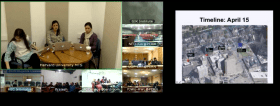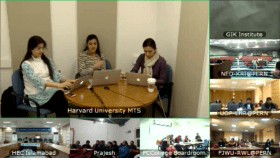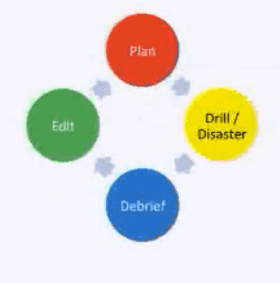SAI concluded its three-part webinar series on Disaster Management and Emergency Response on Tuesday, March 10 with a presentation by Payal Modi, MD, MPH, Fellow, Brigham & Women’s Hospital; International Emergency Medicine Fellowship, Harvard Medical School, titled ‘Planning and Debriefing for Future Disasters.’
Using videoconference software provided by the Higher Education Commission of Pakistan, the webinar engaged seven sites in South Asia with Harvard, including a site in Nepal for the first time.
Dr. Modi offered a general overview of best practices in preparing for disasters, and used cases from real world incidents. She explained that the four phases of disaster response are: 1) Mitigation; 2) Preparedness; 3) Response; and 4) Recovery. The presentation focused on the preparedness phase, which can occur at many levels of an organization: international, national, state, hospital, and within hospital departments.
Dr. Modi explained that the core principles of preparing for disasters include planning, drilling, debriefing, and editing. She commented that planning should take place at a supervisory level with all stakeholders, and should be put in writing so that responsibilities are clearly delineated. Further, relevant information can be gathered by asking questions such as: What is the risk for our area? What underlying causes increase risk? How can we reduce that risk?
Once the risks are identified, planners should review current operations and management plans, and focus on areas that are weak. Dr. Modi emphasized that plans should be constantly updated and edited. After the plan is finalized, planners should ensure that it is distributed to everyone in the organization.
The next important phase is drilling. Drilling it is not a test; it is a way to improve methods and edit the plan. Whenever possible, operational plans can be acted out, for example fire drills in hospitals. On a larger scale, a ‘table top’ approach can work, by discussing challenges and scenarios.The most important part of drilling is the debriefing process, where the drill is analyzed, and strengths and weaknesses are identified. The goal of debriefing is to improve processes and procedures for next time.
Webinar: Incident Command Systems in disasters
The presentation featured several case studies that provide real-world lessons on planning for disasters:
2010 Haiti Earthquake
When a 7.0 magnitude earthquake struck Haiti, around 300,000 people died. Much of the vital infrastructure in the country was damaged, which hindered the response. The response relied heavily on foreign humanitarian response, and the government was criticized for poor communication and a lack of a coordinated plan.
2010 Chile Earthquake
In contrast to Haiti, this 8.8 magnitude earthquake resulted in 525 deaths, but much of the vital infrastructure in the area stayed intact. The response included a mix of external organizations and the government. Dr. Modi explained that the government was in close communication with the public throughout the crisis.
2005 Hurricane Katrina, New Orleans
The storm surge from the hurricane caused multiple breaches of the levees around the city, resulting in 80% of the city being submerged. In planning and preparedness drills, Dr. Modi said that city planners had not foreseen the problem of the levees breaking. About 1,800 people died, and tens of thousands were stranded in the flood zones for days. There were lapses in national, state, and local responses, and a failure of incident command. Dr. Modi explained that the poor response to Hurricane Katrina is now a case study that has influenced communities across the country to change their plans for flooding and hurricane responses.

The efficient response to the Boston Marathon bombing provides valuable lessons for future disasters
2013 Boston Marathon Bombing
Two bomb blasts killed three people in a crowd of spectators at the finish line of the marathon, and injured around 260, many of them seriously. Dr. Modi explained that the response to the bombings was very well-organized, with an effective central incident command structure.
All seriously injured patients were transported to local hospitals within 18 minutes, and were evenly distributed between hospitals. All patients who were transported survived.
Hundreds of medical personnel and police officers were already at the finish line, and were able to assist in the response. Ambulances were prepared to take any sick marathon runners to hospitals. Dr. Modi explained that these ambulances were crucial in ensuring that many injured people survived.
Dr. Modi, who works at Brigham & Women’s Hospital in Boston, then explained the efficient response at that hospital. Four minutes after the explosion, the hospital was notified that they would be receiving critically injured patients. Six minutes later, an incident command meeting was held in the emergency room. Fifteen minutes later, the first patient arrived. During the next 30 minutes, all of the patients were rapidly triaged, and within the next hour, critically injured patients were in the operating room.
According to Dr. Modi, the key factors for an efficient response were communication, organization, and leadership/accountability. Managing the influx of labor was also important, as doctors and nurses had to be spread evenly among patients. The process was successful because the incident command system within the ER worked properly, triage was efficient, and roles were clearly identified.
Dr. Modi has worked with the Aman Foundation to train first responders in Pakistan. In particular, they trained the three ambulance services operating in Karachi to improve coordination and communication between the services. Furthermore, the team also worked with pre-hospital providers, such as the navy, police, security personnel, and ambulance drivers to formulate a disaster plan. The team helped improve communication between hospital administrators, so that mass casualty responses are better coordinated.
Learn more about SAI’s Disaster Management and Emergency Response project.


